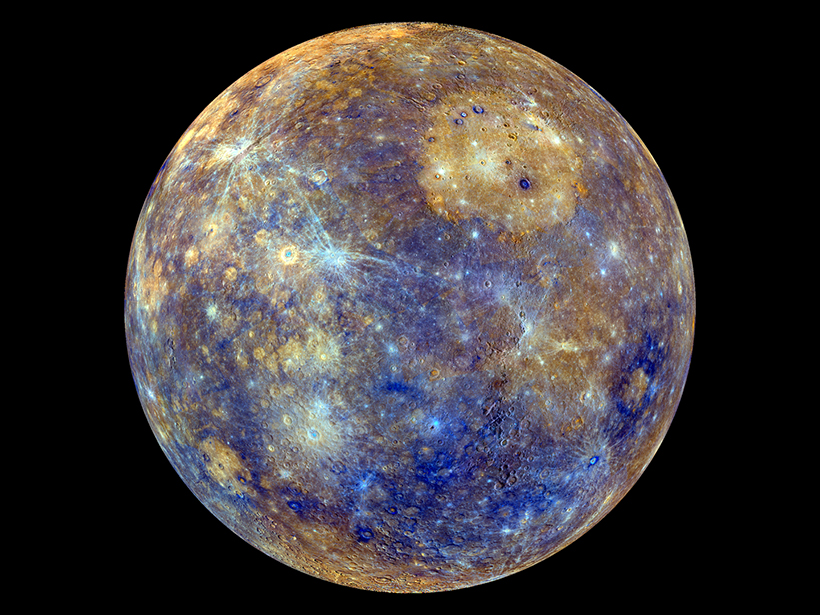The first planet will soon receive its third visitor from Earth.
The visitor, a spacecraft called BepiColombo, is set to launch as early as this weekend. BepiColombo will contain two orbiters, a propulsion unit, and a strong Sun shield to protect it from solar radiation.
BepiColombo aims to study the geophysics, atmosphere, and magnetosphere of Mercury.
BepiColombo aims to study the geophysics, atmosphere, and magnetosphere of Mercury as well as to understand the history of the inner solar system. The spacecraft is a joint mission of the European Space Agency (ESA) and the Japan Aerospace Exploration Agency (JAXA) and will be ESA’s first mission to travel inward toward the Sun.
Two Missions for One Launch
The mission is primarily composed of two orbital craft, one each developed by ESA and JAXA. ESA’s Mercury Planetary Orbiter (MPO) contains an altimeter as well as multiwavelength imagers and spectrometers to study Mercury’s morphology, geochemistry, and composition. JAXA’s Mercury Magnetospheric Orbiter (MMO) hosts a magnetometer, a spectral imager, and plasma physics instruments to study the origin, strength, and extent of the planet’s magnetic field and exosphere.
“The long journey to Mercury has not yet started, but I feel the two science orbiters already have a strong bond between them, thanks to the long history of this mission,” Go Murakami, BepiColombo project scientist at JAXA, said in a statement. “I believe they will achieve a very successful mission with their joint science measurements.”
BepiColombo will create a high-resolution global map of Mercury’s surface at many wavelengths.
To be successful, however, BepiColombo must weather some extreme conditions. Temperatures at Mercury range from extremely hot, up to 450°C, to extremely cold, down to –180°C. MPO’s instruments will use temperature-resistant layers and a coating over its outside as well as radiators and heat pipes to carry away heat created inside the craft. MMO will use a Sun shield before arrival and, afterward, a combination of reflective panels and spinning to reduce and redistribute the heat.
Together, the instruments on BepiColombo will also create a high-resolution global map of Mercury’s surface at many wavelengths. This map, combined with its other investigations, seeks to complement the data collected by previous visits to Mercury. Mercury is the least explored of the four rocky inner planets, having received visits only from NASA missions Mariner 10, from 1974 to 1975, and Mercury Surface, Space Environment, Geochemistry and Ranging (MESSENGER), from 2008 to 2015.
Mysterious Mercury

Mercury is an odd terrestrial planet in many ways. It is the only solar system planet that has a spin-orbit resonance: It spins on its axis three times for every two orbits around the Sun. One year on Mercury is only 88 Earth days long, but a day-night cycle on the smallest planet lasts more than twice as long. It also has the highest orbital eccentricity of any planet and virtually no axial tilt.
That means that some places on Mercury don’t see sunlight for 2 Mercury years, some are in perpetual “high noon” for weeks at a time, and others occasionally see the Sun reverse direction just after rising or just before setting. Some deep impact craters near the poles never see sunlight at all, and scientists have detected water ice deposits trapped within their shadowed basins.
Mercury also is the most heavily cratered of the terrestrial planets, has a solid iron core that dominates its interior structure, and has an evolving orbit that can be explained only using Einstein’s theory of general relativity. It also shows signs of past tectonics and volcanism and has a thin atmosphere. Many of these features were unexpected discoveries from Mariner 10 or MESSENGER.
BepiColombo’s mission scientists hope that studying each of these properties in more detail will provide a deeper understanding of the history of the inner solar system and how planets close to their stars evolve.
Fighting the Sun’s Pull
Traveling in a controlled manner toward the Sun requires more energy than traveling away. The craft must constantly fight the Sun’s gravitational pull to achieve orbital insertion around Mercury. In addition to its solar-electric propulsion system, BepiColombo will control its inward spiral to the Sun by borrowing gravitational energy during a flyby of Earth, two of Venus, and six of Mercury.
BepiColombo’s journey from launch to orbit will take 7 years. Once at Mercury, its mission lifetime will be about 17 months.
BepiColombo is scheduled to launch no earlier than Friday, 19 October, at 9:45 p.m. Eastern time aboard an Ariane 5 rocket. To learn more about BepiColombo’s design and mission goals, watch the video below.
—Kimberly M. S. Cartier (@AstroKimCartier), Staff Writer
Citation:
Cartier, K. M. S. (2018), Mercury mission will map morphology and measure magnetics, Eos, 99, https://doi.org/10.1029/2018EO108127. Published on 18 October 2018.
Text © 2018. The authors. CC BY-NC-ND 3.0
Except where otherwise noted, images are subject to copyright. Any reuse without express permission from the copyright owner is prohibited.

